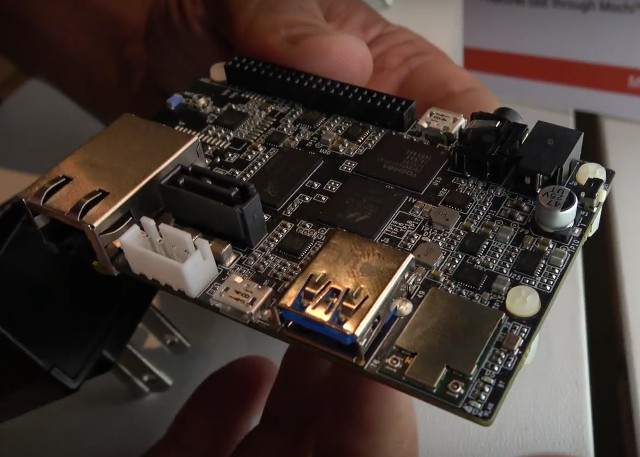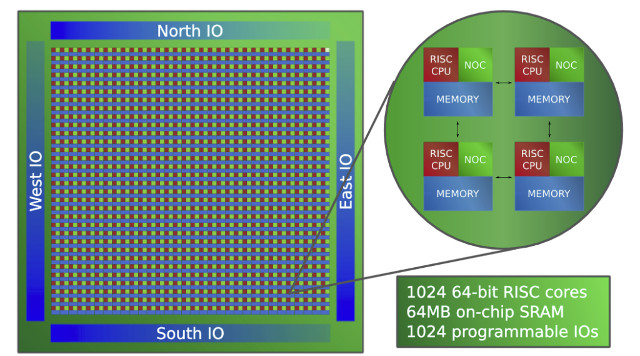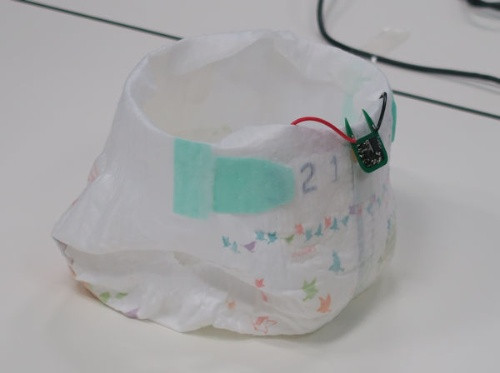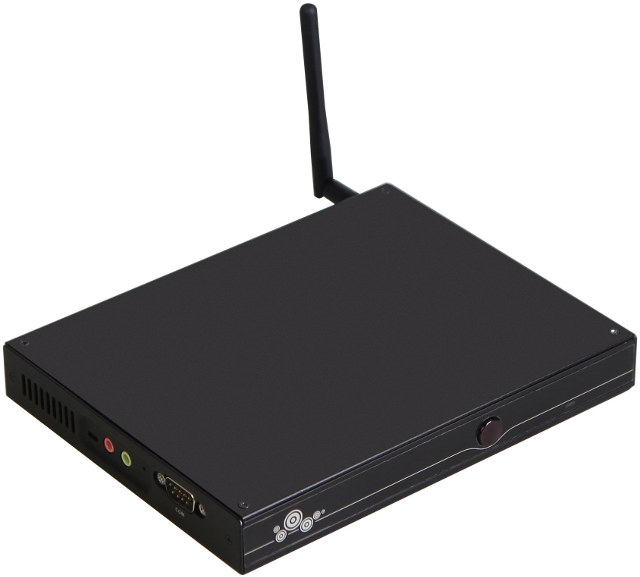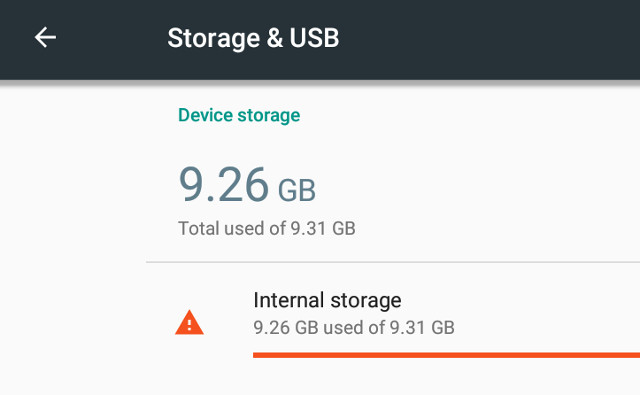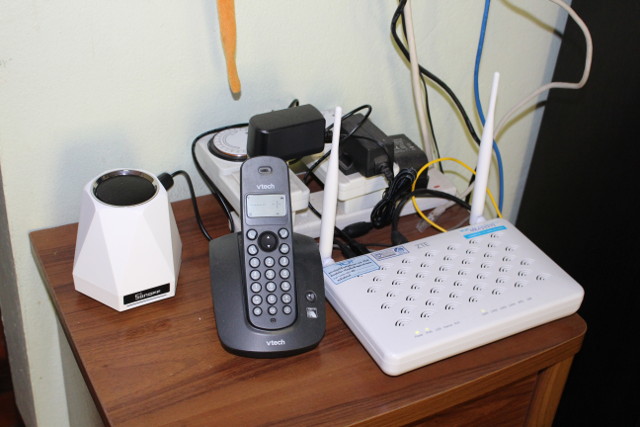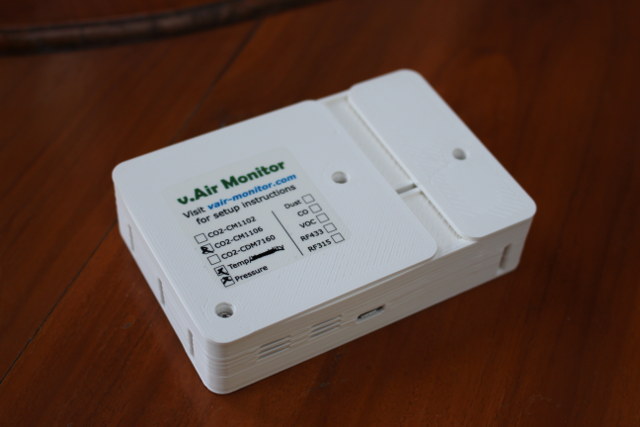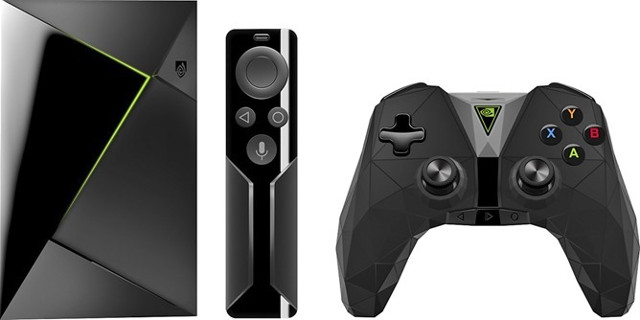Last year, Marvell introduced AndroMeda Box Edge IoT board using 96Boards form factor and running Brillo (now Android Things), but the company has been working on the similarly named AndromedaBox Networking Edge (ANE) board with a tweaked version of 96Boards form factor including Gigabit Ethernet and SATA, and powered by a dual core ARMADA 3700 processor. AndromedaBox Networking Edge specifications: SoC – Marvell ARMADA LP 3700 dual-core ARM Cortex 53 processor @ up to 1.2 GHz System Memory – 512MB LPDDR4 Storage – 8GB eMMC flash, 1x SATA 3.0 port Connectivity – 1x Gigabit Ethernet RJ45 port, 1×1 802.11ac Wi-Fi, and Bluetooth 4.2 USB – 2x micro USB 2.0 port, 1x USB 3.0 port Expansion – 1x PCIe 2.0 (maybe via a slot on the back of the board), 40-pin LS (Low Speed) Expansion connector Power Supply – Likely 8 to 18V input as per 96Boards specs Dimensions – 85 […]
Parallella 1024-core Epiphany-V RISC Processor Coming Soon
Parallella project’s goal is to ” democratize access to parallel computing by offering affordable open source hardware platforms and development tools”, and they’ve already done that with their very first $99 “Supercomputer” board combining a Xilinz Zynq FPGA + ARM SoC to the company’s Epiphany-III 16-core coprocessor. But the company has made progress after their 64-core Epiphany-IV, by taping out Epiphany-V processor with 1024-core last October. Epiphany-V main features and specifications: 1024 64-bit RISC processors 64-bit memory architecture 64-bit and 32-bit IEEE floating point support 64 MB of distributed on-chip SRAM 1024 programmable I/O signals 3x 136-bit wide 2D mesh NOCs (Network-on-Chips) 2052 separate power domains Support for up to one billion shared memory processors Support for up to one petabyte of shared memory (That’s 1,000,000 gigabytes) Binary compatibility with Epiphany III/IV chips Custom ISA extensions for deep learning, communication, and cryptography TSMC 16FF process 4.56 Billion transistors, 117mm2 silicon area With […]
Batteryless, Urine Powered Smart Diapers Notify You When It’s Time to Change Them
One of the downside with current smart wearables is that most need to be recharged quite often, every day, week or month, and we’re still a long way of 10 year battery life offered by typical watches. I’m hopefully that eventually many devices won’t need to be recharged at all as we’ll have made improvements both in terms of power efficiency and energy harvesting using solar, body heat, vibrations and other techniques. Takakuni Douseki, professor at the Department of Electronic and Computer Engineering of Ritsumeikan University, has been working on micro energy harvesting, and his latest “wireless involuntary urination sensor system” notifies the user when it’s time change the diapers without the need of any battery, instead using energy generated by urine and stored in a capacitor in order to transmit the data wirelessly. The prototype is using a modified baby diaper with a 320x5mm activated carbon piece, and a […]
Giada F105D Apollo Lake Mini PC Supports up to 3 Displays via HDMI 2.0, DisplayPort, and VGA Ports
Giada F105D is an upcoming mini PC powered by either a Celeron N3350 dual core or N3450 quad core processor part of Apollo Lake family with up to 4GB RAM, a 2.5″ SATA bay, and three video outputs: HDMI 2.0, DisplayPort and VGA. Except for the processor, F105D-BS200 and F105D-BQ200 mini PCs have the same specifications: SoC F105D-BS200 – Intel Celeron N3350 dual core processor @ 1.1 / 2.4 GHz with 12EU Intel HD 500 graphics (6W TDP) F105D-BQ200 – Intel Celeron N3450 quad core processor @ 1.1 / 2.2 GHz with 12EU Intel HD 500 graphics (6W TDP) System Memory – Up to 4GB DDR3L-1600MHz with 2GB on-board + 2GB on 204-pin SO-DIMM socket Storage – 1x 2.5″ SATA drive bay (max. height 7.5mm), 1x M.2 (PCIe), 1x mSATA III, 1x micro SD slot Video Output VGA up to 2560×1600 @ 60Hz, 24bpp HDMI 2.0 up to 3840×2160 @ […]
Something is “Eating” my Android TV Box Internal Storage!
No, it’s not a joke. I’ve been playing for a while with Eweat R9 Plus Android TV box after inserting a 1TB hard drive in the SATA bay, but while in most other reviews, the apps and files used for testing are just taking around 3 GB, the 9.31 GB storage in that device was completely full, and I have yet to install some apps, and copy some files part of my testing procedure… I did not immediately find out about the “storage full” issue, as I first I just noticed Kodi would not start anywhere, and the default video app would just reboot after adjusting the volume… But let’s check what takes all that space… I had to uninstall 3Dmark in order to be able to take screenshots, which explains why I have a bit more space now, but the system reports all that space (and more???) is taken […]
Sonoff SC WiFi Environmental Monitor mini Review
Yesterday I received two environmental monitors with Sonoff SC and vThings CO2 Monitor, and while I’ve plugged both, I have not had time to look into vThings documentation, but since I’m already using the eWelink app for Sonoff TH16 wireless switch, setting up Sonoff SC just took me a few minutes, so I’ll report my experience with the device in this review. I powered Sonoff SC using the USB port of my modem router, and the green LED on the back of the device started to blink every 2 or 3 seconds. Then I started the eWelink app on my Android phone and taped on the “+” icon to add a new device following the instructions here which are basically the same for all Sonoff devices. Then you need to press the “Audio” button for about 5 seconds until the green LED blinks faster, at which point you can click […]
ESP8266 based Wireless Air Quality & Environmental Monitors Teardown – Sonoff SC and vThings CO2 Monitor
The mailman delivered two parcels today, and interestingly enough they have a similar functionality measuring air quality and environmental data such as temperature. The first package was ITEAD Studio Sonoff SC environmental sensor with ESP8266, an Atmel MCU, DHT11 temperature & humidity sensor, a dust detector, a light sensor, and a microphone, while the second was v-Air Monitor vThings CO2 monitor v3 also based on ESP8266 with a CO2 sensor and other optional sensors. I’ll test both with their stock firmware later on, but today I’ll have a look at the hardware design. v-Air Monitor vThings CO2 monitor specifications While I’ve already written about Sonoff SC, it’s the first time I cover v.Air Monitor products, so let’s start with the specifications of vThings CO2 Monitor v3: SoC – Espressif ESP8266 WiSoC Connectivity 802.11 b/g/n WiFi Optional RF315 / 433 MHz RF module Sensors CO2 Sensor (one of them) CM1106 NDIR […]
Second Generation NVIDIA Shield Android TV Box Photos Leaked Ahead of Launch
NVIDIA Shield Android TV box may have launched in the first part of 2015, but even at the end of 2016 it’s still one of the best Android TV boxes with a powerful Tegra X1 processor, 3GB RAM, 4K video support, HD audio pass-through, the fastest GPU found in TV boxes so far, Netflix HD & 4K certified, and more. The company is allegedly preparing to launch a new model, and some photos have been leaked to Android Police. The design of the box looks basically identical to the new model, but it comes in two different sizes maybe because of extra ports and internal storage, and the game controller has been re-designed with a mix of triangular shapes. What we don’t know are the specifications. The company may have done a simple refresh, keeping Tegra X1 processor, increasing the memory and storage capacity, and possibly adding some extra interfaces, […]


